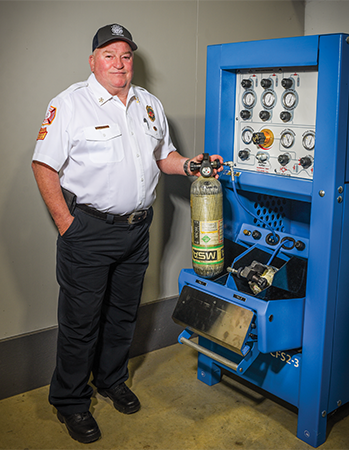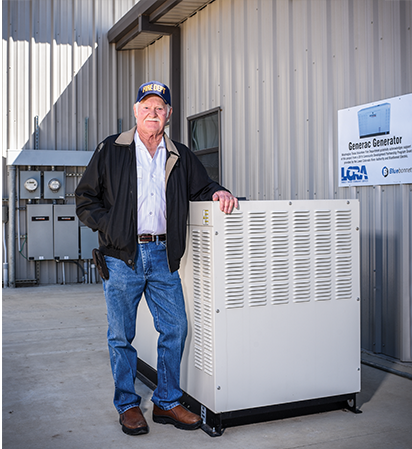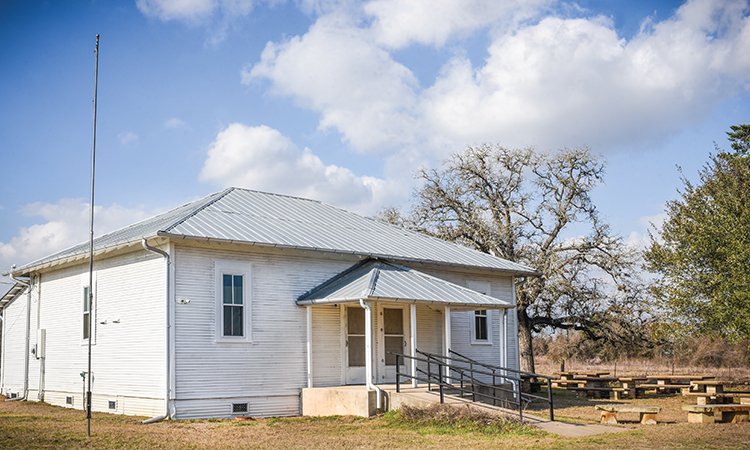Andrew Murphy, a member of the Lincoln Volunteer Fire Department, displays the self-contained breathing system used amid heavy smoke. The department received a $19,893 grant in 2020 for a device to refill firefighters’ oxygen tanks. The device saves precious minutes in response time. (Sarah Beal photo)
Story by Clayton Stromberger
Photos by Sarah Beal
Travel to communities and picturesque parts of the Bluebonnet Electric Cooperative service area, and you will likely pass dozens of locations — a volunteer fire station, a community center, a small nonprofit — with equipment, a new or renovated building, a park or a program made possible with help from the Lower Colorado River Authority and Bluebonnet.
In Shelby, which is in Austin County, American Legion Post 602 was refurbished in 2020 with fresh paint and new doors and windows. Over in Dime Box in Lee County, picnic tables now grace the first phase of a new public park that will be centered around historic Black Bridge. Swing by the library in Round Top in Fayette County to enjoy the new air conditioning and heating system. The McMahan Community Women’s Club in Caldwell County upgraded its wiring and lighting in 2020, and the New Ulm Volunteer Fire Department in Austin County now has a helipad for emergency helicopter landings.
Those are just a few examples of shared generosity. In the past five years, 31 grants totaling $700,328 have been awarded to area groups by LCRA and Bluebonnet. The list of Community Development Partnership Program, or CDPP, grants will grow again this year.
“The CDPP grants are one of the many ways we connect with, support and give back to the communities we serve,” said Matt Benkte, Bluebonnet’s general manager. “The funds make it possible for recipients to improve lives by helping people through difficult times, or save lives by providing much-needed vehicles and critical equipment to volunteer fire departments and other public safety organizations. We are proud to partner with people who are making tremendous differences in our communities.”
Groups and projects in Bluebonnet’s service area have been receiving CDPP grants since 1996. Funding has gone to numerous nonprofit organizations, including volunteer fire departments, emergency responders, libraries, civic groups, community centers and museums. The grants help pay for capital improvement projects that might otherwise not be affordable. Bluebonnet‘s five community representatives work in their regions to publicize the CDPP grants and encourage eligible organizations to apply.
“This program really enhances our communities, especially in smaller rural areas,” said Deborah Rogers, who is Bluebonnet’s Bastrop-area community representative and also a member of the CDPP Review Committee for LCRA.
There are two CDPP grant application cycles each year, in January and July. Groups that request more than $5,000 must supply matching funds of at least 20 percent of their project’s cost. Grants larger than $25,000 are awarded less frequently and are intended for projects with long-term impact on a broad community. These large grants are competitive, comprising no more than 30 percent of grants awarded.
Get details about the CDPP program from LCRA at https://www.lcra.org/community-services/ community-grant-program/#about.
Before the pandemic, an oversize cardboard check replica was handed out for jubilant group photos. Those ceremonies are on hold until it’s safe to resume them. But the CDPP grant program continues full-steam.
Read on for five stories of how recent CDPP grants to Bluebonnet-area organizations have made a lasting positive impact.
Lincoln Volunteer Fire Department
$19,893 for a new oxygen tank-refill system

Chief Spencer Schneider, above, with the machine that can refill two oxygen tanks at a time. The device saves precious minutes in response time.
Community fundraising meals keep a rural fire department going, plate by plate, bowl by bowl. So it’s lucky for the Lincoln Volunteer Fire Department in Lee County that chief Spencer Schneider is fearless in front of a huge, bubbling pot of chili. “I’ve cooked up to 600 pounds at a time for fire department functions,” Schneider said matter-of-factly, along with “many a gallon” of stew.
The fire chief’s cooking prowess helped the VFD raise $4,973 by spring 2020 to go toward purchase of a piece of essential equipment — a refill system for the oxygen tanks that firefighters use in hazardous air situations. Without their own oxygen refill center, Lincoln volunteer firefighters had to drive 8 miles to the Giddings fire department’s station to refill their three, 4-foot metal oxygen canisters. Sometimes they would ask for help from another fire department. Each of those trips cost precious minutes of response time.
In May 2020, a $19,893 CDPP grant provided the additional money needed to buy the refill station — and it’s already increased efficiency. “I can send guys back to the station, and it averages less than five minutes” to fill a canister, Schneider said.
Lincoln sits in the middle of Lee County, on Texas 21 between Giddings and Lexington, which each have oxygen refill stations. Smaller volunteer fire departments in the area are now critical minutes closer to an oxygen refill. That means Schneider can share not only his chili recipe with fellow volunteers in nearby towns, but also a potentially life-saving refill of oxygen.
Washington Volunteer Fire Department
$19,740 for an emergency generator
Fire is a wily foe. Clyde Miller, longtime chief of the Washington Volunteer Fire Department in northeast Washington County, knows this well. He learned it firsthand as a rangy teenager battling blazes in the mountains of his native West Virginia, and he has honed that understanding over five decades as a volunteer firefighter in Washington County. His father-in-law helped start the volunteer department in 1972. Miller is one of a handful of the founding members who are still at it.

Washington Volunteer Fire Department chief Clyde Miller, above, with the 48 kilowatt emergency generator purchased with a grant from LCRA and Bluebonnet. The generator's 500-gallon propane tank could keep it running for up to a week before a refill.
When dealing with fire — or floods, hurricanes, massive storms, and any other natural upheavals that might require county volunteers to leap into action — it pays to stay a step ahead of danger. So as he began his third stint as chief 12 years ago, Miller wondered: What was needed to take the VFD’s abilities up to a higher level of preparedness?
One key piece of equipment came to mind: An emergency generator, for those moments when a power outage from a hurricane or massive storm might threaten the volunteers’ ability to respond effectively to a fire or natural disaster. In 2011, the department began saving money from fundraisers, and in the fall of 2018, the VFD received a $19,740 CDPP grant for the generator.
“This is a really valuable piece of equipment,” Miller said proudly. Without it, a downed power line could prevent firefighters from reaching or recharging life-saving equipment, or retrieving water from the VFD’s well. The VFD is on FM 1155, about 3 miles south of Washington-on-the-Brazos State Park.
The generator is already providing the assurance of reliable power to Washington County EMS’s 24-hour helicopter rescue team, which works out of the VFD’s recently constructed 12,600-square-foot station on Texas 105. During a disaster, the generator guarantees the fire station can be a safe place to distribute water and food and host a relief organization like the Red Cross.
Chief Miller and the department are now much more prepared to protect their community in the event of a disaster. “These grants are really something nice,” Miller said. “It’s a way of giving back to the community.”
Crowe’s Nest Farm
$24,500 to build a 1-acre pond and wetland habitat

The wetlands habitat pond was built at Crowe's Nest Farm, near Manor, with the help of a grant in 2020.
It’s been a tough 13 months for Crowe’s Nest Farm, which has been inviting the public — especially schoolchildren — to visit its grounds and learn about our region’s natural and agricultural resources since it was founded in 1983 by educator Dr. Diane Crowe.
This 100-acre working farm, which moved from Austin to its present location about 8 miles southeast of Manor in Travis County in 1998, is funded primarily by visitor admission fees. For decades, groups of children have rolled in on yellow school buses to see farm animals, visit the Big Red Barn, tour the gardens, go on a hayride and learn from educational exhibits. But the pandemic that was declared in March 2020 led to a catastrophic loss of income for the organization. “There were 40,000 kids planning to come on field trips who all had to cancel,” said Dave Williams, who has been with Crowe’s Nest since its founding and is now executive director.
Workers at the farm, at 10300 Taylor Lane, expect to finish repairs, replant after February's damaging statewide winter storm and re-open in early March. Hours will be 10 a.m. to 2 p.m., Tuesday through Saturday.
An ongoing GoFundMe online fundraiser has helped the organization hang on. Meantime, the crew at Crowe’s Nest Farm have one shimmering new bright spot to lift their spirits – a beautiful, one-acre water capture pond and wetlands habitat, created with the assistance of a $24,500 CDPP grant awarded in May 2020. The project transformed an unsightly low runoff area into a sparkling highlight for future tours.
“We have such a tremendous number of birds that fly through here,” Williams said, “so it’s going to be a great stop-off location for great blue herons, white egrets and other native species, along with geese, ducks, cranes and other birds.”
Native plants will form a berm on the north side of the pond to block the winter winds and create a wildlife habitat. A windmilldriven fountain and a solar-powered pump fountain will aerate the water to prevent stagnation. Eventually, the pond will be stocked with largemouth bass, perch and catfish.
“We’ve been wanting to put in a pond there since we arrived in 1998,” Williams said, “and so this was a huge blessing last year.”
Delhi Volunteer Fire Department
$50,000 to complete a new fire station

Chief Danney Rodgers helped design the Delhi Volunteer Fire Department's fire station in Caldwell County. The station was completed in 2017 with the help of a grant from LCRA and Bluebonnet.
Not every firefighter keeps a department truck parked in front of their house. But when Danney Rodgers began his term as chief of the Delhi Volunteer Fire Department in east Caldwell County in 2010, he didn’t really have a choice – the department didn’t yet have funds to build a station, so its equipment was stored in three different locations, including in his front yard.
“We had space at our homestead, so the truck wasn’t in the way,” Rodgers recalls. “But logistically it’s a problem when equipment is scattered around like that. If I wasn’t home, someone would have to drive out here to get the truck before responding to a call.”
The Delhi VFD hoped to build a first-class station house on Texas 304 in this unincorporated community about 19 miles southeast of Lockhart. They had built the outer shell of their station. A $50,000 CDPP grant awarded in spring 2017 helped complete phase two of the project — everything from electrical wiring and plumbing to interior walls and bathrooms.
The station was carefully designed by Rodgers with input from department members and other VFDs in the region. Countless fundraisers at the little community center across the street from the site helped provide matching funds. The goal was to build a state-of-the-art station to last for “30, 40, 50 years,” Rodgers said.
Now everything can be stored in one 9,400-square-foot location, which is reducing response times, Rodgers said. There is space for department training, and a shiny industrial kitchen to handle large fundraising events. As a bonus, the Delhi community — which has steadfastly supported the department through the years — now has its first large, climate-controlled gathering spot that area residents can use.
“It’s a great addition to our county and our community,” Rodgers said. “Everybody is super proud of it. And I think it’s going to be there for a long, long time.”
Rosanky Community Center
$14,835 for renovations to its historic building

The 125-year-old Rosanky Community Center received essential renovations thanks to a CDPP grant in 2020.
The historic schoolhouse that now serves as the Rosanky Community Center in south Bastrop County has hosted lots of family reunions, meetings and church lunches over the decades from its quiet perch at the end of Main Street. Photos on the center’s Facebook page show scenes from such an event in the 1960s, with folks gathered at the brickand-concrete picnic tables in front of the now 125-year-old structure.
“It’s kind of the center of the town down here,” community center president James Rose said. “It brings people together. And it’s one of the last of the old buildings still standing.” The center is about 15 miles southwest of Smithville, on 135 Main St. in the unincorporated Rosanky area.
All those winters and summers can take a toll on a wooden building, and a few years ago, the old schoolhouse was in serious need of “a lot of TLC,” Rose said. Bulky air conditioning units protruded from its windows. Insulation-free walls meant the building was not energy-efficient or easy to cool on a broiling summer afternoon. The aging septic system was always in danger of overflowing.
The aging septic system was always in danger of overflowing. Today the Rosanky Community Center has been transformed. Thanks to a $14,835 CDPP grant announced in May 2020 — which was matched with $7,988 in funds raised by the center — the unsightly AC units are gone, replaced by an energy-efficient system nestled artfully along the back of the building. Foam insulation now fills the old gap between the exterior and interior boards, and the narrow, old-fashioned windows have double panes. There’s a new septic system there, too.
The benefits brought by the renovations are not only visible, but also audible, Rose said. “When we had meetings in there before,” he said, “and we had the AC or heat on, you couldn’t even hear yourself. Now you can’t even hear that they’re on.” The building itself has been closed to community gatherings due to the pandemic, but it continues to serve as a polling location, and recently was the site for water distribution after February’s winter storm.
On a sunny day the historic building — simple and square as a Monopoly house — glows in its white paint, looking trim and hardy alongside a gleaming playground also made possible by a CDPP grant, awarded in spring 2017. Center volunteers teamed up with Bluebonnet to install the heavy-duty play equipment themselves. The playground is a source of pride for the community, Rose said.
“Before we put this in, people here had to drive all the way to Smithville or Bastrop with their kids to find a playground,” he said. “The community just loves it. Families come over all the time and enjoy it. And we would not have been able to build it without that grant.
Download this story as it appeared in the Texas Co-op Power magazine »





